Contents
Periwinkle is a very unpretentious flowering plant. A variety of Variegata is also decorative due to the variegated green-white foliage. It is not difficult to take care of him, but it is still necessary to know in advance the most important nuances regarding planting, agricultural technology, and reproduction.
Botanical description of periwinkle large Variegata
Periwinkle is a perennial evergreen shrub from the Kutrovye family. Its variety Variegata (Variegata) differs from the “original” in two-tone white-green leaves.
The botanical characteristics of the periwinkle large Variegata are as follows:
- superficial (goes 10-15 cm deep), the root system actively expanding in breadth, the roots are thin, “fibrous”;
- the stems of the plant are creeping, about 1,5 m long, herbaceous or semi-lignified, with pronounced internodes, from which roots easily sprout upon contact with the soil;
- peduncles are smooth or with rare “villi”, height – 0,6-0,7 m;
- leaves are hard, smooth, glossy, oppositely arranged, 7-9 cm long and 5-6 cm wide, almost round, sharply tapering towards the tip, with distinct veins;
- the color of the leaves of the plant is a creamy white border and spots on a rich green background (the intensity of the manifestation of “spotting” depends on the cultivation conditions and the age of the bush);
- petioles are short (1,5-2 cm), “hairy”;
- flowers are axillary, solitary, five-petalled, 5-6 cm in diameter, lavender or blue-lilac with an almost imperceptible aroma.
Other important features of the Periwinkle Variegata plant that are important for gardeners:
- long (April-September) annual flowering;
- ease of propagation by both generative (seeds) and vegetative (cuttings, rooting layering, plant division) methods;
- frost resistance up to -30 °С;
- ability to adapt to direct sunlight and deep shade;
- drought tolerance;
- undemanding to the quality of the substrate;
- good resistance to pathogenic fungi and harmful insects.
Periwinkle variegated is planted mainly where a green flowering “carpet” is needed. The plant looks beautiful on landscape flower beds, alpine slides, rockeries. Less commonly, low curbs are formed from it. It blooms not too abundantly, but the decorativeness of the flower bed does not suffer from this.
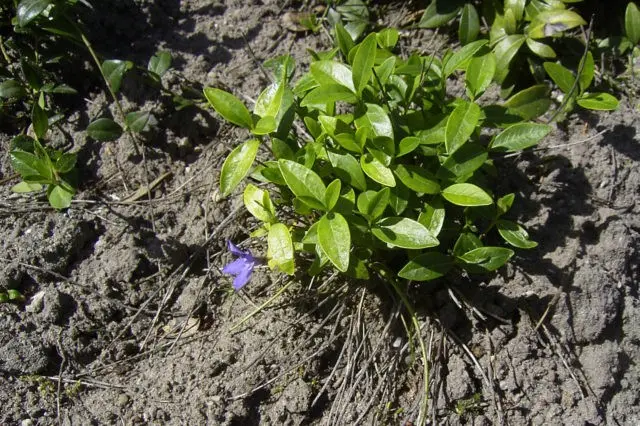
Periwinkle large Variegata grows rapidly, covering the space allotted to it with a continuous “green carpet”
How to plant seeds
Growing periwinkle large Variegata from seeds is not a very popular method of propagation. The plant will begin to bloom only 3 years after the seedlings are planted in the ground.
Seed preparation
Before planting, the seeds of periwinkle variegated are culled, discarding those that definitely will not germinate. They are soaked in saline (a tablespoon per 0,5 liters of water). It takes 10-15 minutes for the seeds without germs to float to the surface.
The second important stage of preparation is disinfection. Self-collected seeds are soaked in a fungicide of biological origin (Alirin-B, Maxim), diluted according to the instructions, for 15-20 minutes. For the same purpose, a pale pink solution of potassium permanganate is used, but then the processing time increases by 1,5-2 hours. Optionally, a few drops of any biostimulant (Kornevin, Epin) are added to the liquid to accelerate seed germination.
Growing seedlings
For seedlings, the seeds of the periwinkle of a large Variegata are planted in the last days of March or in the first decade of April:
- A shallow wide container with 2/3 drainage holes is filled with seedling soil or a mixture of peat and fine sand (1: 1). The soil is moderately moistened.
- Seeds are planted one at a time to a maximum depth of 2 cm with an interval of 3-4 cm. They are not covered with earth, they are sprayed with a spray gun.
- The container is tightened with black plastic wrap or covered with a thick cloth and cleaned in a dark place. Landings provide a temperature of 23-25 ° C. The container is ventilated daily for 5-7 minutes, getting rid of the accumulated condensate.
- The first shoots appear after 7-10 days. Immediately after this, the container is transferred to the light. Water moderately, as the topsoil dries.
- In the phase of the 4th true leaf, a pick is carried out. Seedlings of the periwinkle of the large Variegata by this time grow to 8-9 cm.
Seedlings of periwinkle large Variegata are transferred to the ground in the first decade of May. Holes with an interval of 20-25 cm are dug so deep that an earthen clod with roots fits in them. At the bottom you can throw a handful of humus. After planting, the plants are moderately watered. You can not deepen the root collar.
Landing in open ground
Periwinkle large Variegata can be sown directly into the ground in spring and autumn. The main thing is to choose a non-hot cloudy day for this. When sowing in winter, it is important to calculate the time so that 2-3 weeks are left before the first frost. If you hurry, the seeds will have time to germinate, the seedlings will die in winter. In spring, time is not so important, but you should not rush and plant a plant when there is still a threat of returning frosts.
Site selection and preparation
The optimal substrate for periwinkle large Variegata is nutritious, loose. But he easily “reconciles” with soil of poorer quality. Acidity is unprincipled for him, the plant will take root in both moderately acidic and alkaline substrates.
Periwinkle large Variegata feels great in partial shade. In dense thickets, he will also survive, but will not bloom, the variegated color of the leaves will disappear.
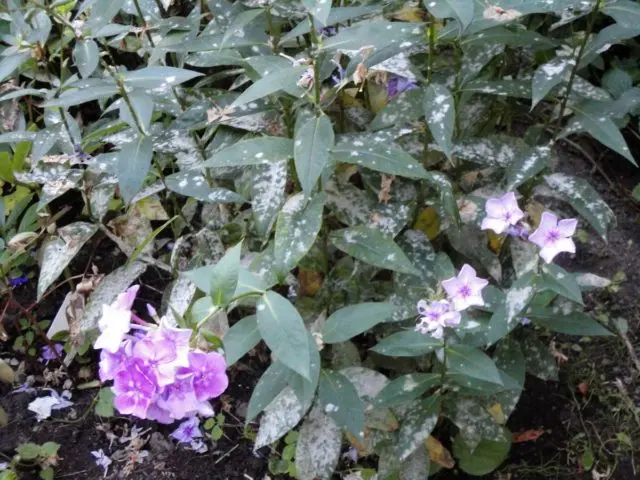
Under direct sunlight, the large Variegata periwinkle will have to be watered more often, but it will also endure such conditions.
Preparation of the landing site for the plant is standard:
- dig the soil to a depth of one spade bayonet;
- remove weeds, other plant debris, stones;
- add humus (up to 5 l / m²) and complex fertilizer for flowering garden plants to very “poor” soil;
- add sand to the “heavy” soil, and powdered clay to the “light” soil (in approximately the same proportion as humus).
Landing stages
The very planting of the seeds of the periwinkle of a large Variegata is extremely simple:
- Immediately before the procedure, the soil is slightly loosened.
- Make grooves up to 2 cm deep, spill the bottom with water. When it is absorbed, a thin layer of sand is poured.
- Sow seeds at intervals of 15-20 cm. Some gardeners prefer to sow them more often, and then transplant seedlings, avoiding “crowding”.
- The grooves are sprinkled with soil, rammed. The flower bed is watered again.
Watering and feeding
Growing in fertile soil, the large periwinkle Variegata needs to be fed once every 3-4 years, not more often. In the spring, when the soil thaws enough, humus or rotted compost is added (2-3 liters per adult plant over 5 years old). After 12-15 days, it is watered with a solution of any mineral nitrogen fertilizer (15-20 g per 10 l).
In autumn, plants are fed with phosphorus and potassium (in dry form or diluted with water). Nitrogen is excluded at this time, it prevents normal preparation for winter. Natural alternative to fertilizers – wood ash, dolomite flour, ground eggshells.
The periwinkle large Variegata is most sensitive to the lack of moisture in the soil in the first two years after planting. It is recommended to control the level of soil moisture and water the plant when it dries out 3-5 cm deep.
The following factors influence the frequency of watering:
- season (in spring, during the period of active vegetation, the plant especially needs watering)
- type of substrate (water evaporates faster from light soil);
- the weather outside (in the heat you need more frequent watering).
The frequency of watering the periwinkle of a large Variegata | ||
Age of the plant | Watering frequency | |
During the heat | In cool cloudy weather | |
1-2 years | Once every 2-3 days | Once every 4-6 days |
3-4 years | 4-6 days | 8-10 days |
5 years and older | 7-10 days | 12-15 days |
The nuances of planting a periwinkle of a large Variegata and caring for it:
Diseases and pests
The large Variegata periwinkle rarely suffers from diseases and insects. But it is still recommended to inspect the plantings for suspicious symptoms. The plant may be affected:
- powdery mildew (whitish powdery coating on all parts of the plant);
- rust (saffron-yellow “hairy” coating on the underside of the leaves, gradually “compacting” and changing color to rusty).
Fungicides are used to control fungal diseases on plants. The preparations tested by several generations of gardeners are Bordeaux mixture and copper sulphate. More modern means – Topaz, Skor, Horus, Kuprozan. The concentration of the solution, the number and frequency of treatments is determined by the instruction.
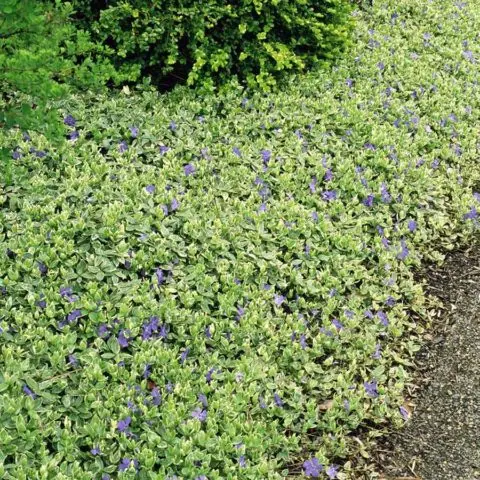
Powdery mildew is one of the most common diseases that almost any horticultural crop can suffer from.
Of the periwinkle pests, the large Variegata can attack:
- aphid (small insects of different colors – from salad green and yellowish to black-brown). They stick around the plant with whole colonies, preferring to settle on the tops of shoots, buds, young leaves. Affected tissues become discolored, dry and die.
- Shield (grayish-brown “bumps”, gradually increasing in volume). Like aphids, it feeds on plant sap. The tissues around the sucked pests gradually change color to red-yellow.
To combat aphids, any universal broad-spectrum insecticide (Fitoverm, Aktara, Iskra-Bio) is suitable. Shchitovok destroy Actellik, Fufanon, Phosphamide.
Methods of reproduction
To propagate the periwinkle of a large Variegata, gardeners resort to one of the vegetative methods. This makes it easier and faster.
Cutting
The cutting is the top of the periwinkle shoot of a large Variegata, about 20 cm long. The lower cut is made at an angle of about 45 °, and half of each leaf is also removed. The base of the cutting is sprinkled with any powdered root stimulator.
Plants are planted in late August or early autumn according to the same algorithm as periwinkle seedlings. The interval between them is 20-30 cm.
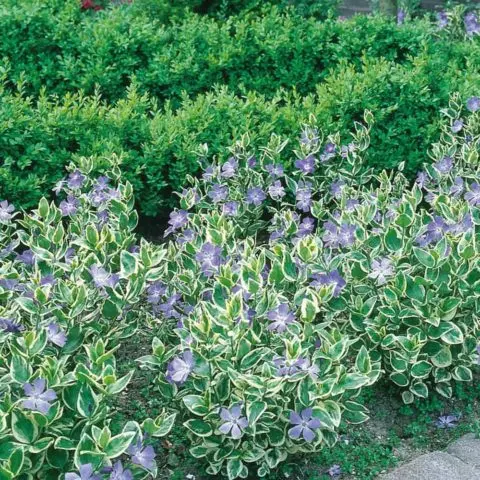
Periwinkle cuttings of large Variegata root in 15-20 days
Division of the bush
This method is only suitable for adult Variegata periwinkle bushes (5 years and older). The procedure is carried out in late spring or early autumn. The bush is dug out of the soil, shake off the earth from the roots. If possible, they are untwisted with their hands, where it does not work out, they are cut with a knife. One plant is divided into 2-3 approximately equal parts, immediately planted in a new place.
Preparation for winter
In relatively warm regions, the periwinkle large Variegata winters calmly without any special preparation. But in temperate climates (and in more severe ones) it is better to play it safe.
In autumn, the periwinkle bush of the large Variegata is pruned, removing shoots that clearly protrude beyond the flower bed, dry, broken. It is also useful for the formation of buds for the next season. The soil is weeded, it is desirable to mulch it.
The flower bed is tightened with covering material or covered with spruce branches. As soon as enough snow falls, they throw it on top, creating a snowdrift. A crust of hard crust forms on the surface, it is recommended to break it several times during the winter.
Photo in landscape design
In the photo you can see what a flower looks like in plantings near the house.

Periwinkle large Variegata is successfully used by gardeners as a groundcover

“Lawn” from the periwinkle of a large Variegata looks very elegant
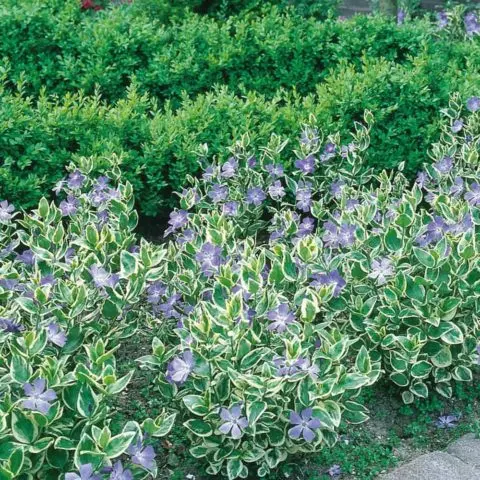
The periwinkle border of the large Variegata is an interesting border for both the flower bed and the garden path

The periwinkle bushes of the large Variegata look good, “weaving” the stones of the alpine slides
Conclusion
Periwinkle large Variegata is valued by gardeners for its ability to “close” vast areas, adapt to a wide range of climatic and weather conditions, cold resistance and rare undemanding care. The agrotechnics of the plant is extremely simple, planting and caring for the periwinkle, even beginners can reproduce it.









